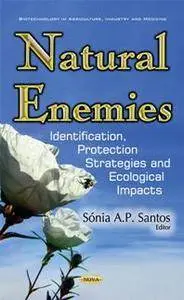Natural Enemies :
Identification, Protection Strategies and Ecological Impacts
by Sonia A. P. Santos
English | 2017 | ISBN: 1634859219 | 227 Pages | PDF | 6.06 MB
Identification, Protection Strategies and Ecological Impacts
by Sonia A. P. Santos
English | 2017 | ISBN: 1634859219 | 227 Pages | PDF | 6.06 MB
Natural enemies are organisms that kill or reduce the activity of other organisms and are particularly useful and functionally relevant in agricultural ecosystems due to their contribution to biological control. Every year, arthropod pest outbreaks cause serious losses in agricultural production and to the income of farmers. Sustainable crop protection strategies, through the conservation or enhancement of natural enemies in agroecosystems, can increase production and food quality and security.
This book includes a broad range of ecological issues about the identification, protection strategies and impacts of agricultural practices on important groups of natural enemies. The core focus includes specific studies on predatory species (e.g., mites, spiders, anthocorids, nabids, carabids, and coccinellids) as well as parasitoid species (hymenopterans). Chapter 1 presents a case study performed in Spanish olive groves with new approaches towards the promotion of biological control mechanisms through the conservation and restoration of natural ecological infrastructures. Chapter 2 focus on the biological control of Oligonychus perseae (Tuttle, Baker and Abbatiello), a herbivore mite specific to avocados, performed by predatory mite species (Euseius stipulatus (Athias-Henriot), E. scutalis (Athias-Henriot), Neoseiulus californicus (McGregor), Galendromus annectens (De Leon) and G. helveolus (Chant)) in a climate change scenario. Chapter 3 provides an overview of the effects of the most common agricultural practices on the biodiversity and life-history parameters of spiders, one of the most abundant and diverse groups of predators in agroecosystems. Chapter 4 shows that crop management can influence the movement of natural enemies that can migrate to surrounding areas. Methods used to determine the movement of natural enemies, their characteristics, as well as advantages and disadvantages of each method are described. Chapter 5 discusses several management strategies required to increase the abundance of the parasitoid species, Psyttalia concolor (Szepligeti) (Hymenoptera: Braconidae), as potential biological control agent of the key pest of the olive tree, the olive fruit fly Bactrocera oleae (Rossi) (Diptera: Tephritidae). Chapter 6 reviews the communities of native parasitoid associated with Dryocosmus kuriphilus Yasumatsu (Hymenoptera: Cynipidae), a gall-inducing insect, native to China, that attacks buds of trees from the genus Castanea in several invaded countries of Asia, Europe and the USA.



